Guest posting is one of the most popular online marketing techniques, reaping some of the most fruitful results. On this page, you will find everything that you need to know about guest posting.
So, first things first, what is guest blogging/guest posting?

Going by the definition, guest posting means creating a blog post and publishing it on somebody else’s website or blog.
It’s an age-old practice that “SEOs” and marketers have been using extensively for reaping various benefits. And in the next section, we are talking about them.
Even the most popular, most successful and most appreciated digital marketers have said only the good things about guest posting. Certainly, it has been beneficial to them. But how exactly?

Well, here is a list of benefits that you can reap with guest posting
One blatant revelation – the primary reason why most people guest blog is because it helps them
build links. But is that the only way to benefit from it?
Well, in a number of cases, the blog host may not allow you to link to your website and it may still
be a great deal. This is because your website will get exposure to a wider audience even if it doesn’t
get a direct link.

So, if you get the liberty to introduce yourself (yes, we’ll come to that) in the guest blog, or at the end of the guest blog, or to add a no-follow link or to mention your name or social media handles
in or after it, it’s still worth it.
No-follow links: These are the links that have a rel=”nofollow” HTML tag applied to them. The purpose of this tag is to indicate to search engines that a particular link is to be ignored.
Thus, these links don’t pass page rank. Plus, they aren’t known to impact search rankings either.
A brand with a social media following and a great search engine presence is always better than a
brand that only has one.

For a fact, guest posts don’t only help you earn better backlinks, but also helps improve your brand’s
social media presence as the guest blog that you got published will most probably be shared across
the host blogger’s social media channels and email lists.
And that’s just how The Social MS has been using guest posting.
Publishing guest blogs on multiple relevant blogs and websites such as Hubspot and Jeff Bulla’s blog,
they’vesuccessfully multiplied their social media following and added hundreds and hundreds of
email signups as well.
Indeed, every guest post written by you can take your brand places.

Who doesn’t want to have a good niche reputation?
It’s obvious. If you are offering your products or services to a niche audience, you would like your
audience knowing you for your authority.
Guest posting greatly helps this purpose.

Publish a super-useful content piece on a good (authoritative) website/blog, and that’ll be a
significant step towards building your online authority.
Although link building doesn’t have to be the primary motive behind guest posting, it’s one great
by-product that you will enjoy.

Yes, most of the online blogs that you may approach for guest posting may allow you to link
to your website.
This will help you step up your website’s backlink profile, unlocking doors to sustainable search
engine success.
Just as guest posting can work wonders for establishing your authority, it can also help boost
awareness around your brand,
One of the common challenges that most businesses have a tough time dealing with is bringing
their business in front of their prospects.
And guest posting can help them achieve that.

The definition of guest posting itself says that you are going to publish your blog post on someone
else’s blog.That means exposure (already mentioned, yes) leading to more lead opportunities.

Take it like this. Your post is going to be read by a wider audience. And as you are going to guest
post on a relevant blog/website, its audience will surely have at least some of your prospects.
So, they will get to read your content and learn about your business (in one way or another).
This will boost your chances of having more qualified leads as if they like your business; they may
as well convert.
Content is king and marketers have known this for years. That’s why the demand for quality content
never goes out.
Everyone wants it. Everyone likes to have it on their media channels. Everyone can accept it.
So, if you are wondering how the host blogger will benefit, this is the answer.
They get quality content without paying for it.

Clearly, it’s a win-win for both parties.
But this doesn’t mean that we can take guest posting for granted. Bloggers wouldn’t generally allow
guest posts with no reason. There needs to be some useful benefit that you’ll need to present. We’ll
learn more about that in the sections to come.
Okay, so guest posting is beneficial for you and the host blogger. So can we call it a happy ending?
One common mistake that many marketers make is going for quantity over quality. But SEO doesn’t
work that way.
This is the reason why it’s crucial to ensure that the blogs that you are guest blogging on are qualified. And how to do that?
Let us see how to efficiently assess guest blogging opportunities and pick the best of them.
Like you’d do it for any other marketing campaign, identifying your goals is super important while
guest posting as well.
And as mentioned in the previous section, there’s a number of ways that you can benefit from guest
posting. The question is, which one are you aiming at?
So, make sure you know what you want to achieve from this guest posting campaign.
For reference, here’s a list of common goals that marketers look forward to achieving from guest posting:
Now this doesn’t mean that your goals should lie within the above-mentioned parameters. These are to give you an idea about what you can achieve through guest posting.Moving further, let’s look at the other important factors that matter.
One common term that SEOs have always been hearing and talking about is DA, i.e., domain authority.

A simple search ranking predicting factor, DA is widely used for depicting a website’s authority,
backlink profile and search performance.
So, how does DA help in filtering qualified guest posting websites?
Well, going by the simplest approach, higher the DA, better the website’s link profile and potential
search performance. But the thing is, that’s not exactly how it works.
Yes, some marketers primarily look for websites with a higher domain authority to guest post on (told you, that’s the simplest approach). However, sometimes, this can backfire as well, and here
are three reasons why.
Another metric on the list — citation flow.
For those who are new to the term, it’s a metric invented by Majestic (one of the popular search engine optimization tools).

Its idea is to identify how influential a backlink can be for your website by considering the popularity of websites that your target guest posting blog/websites is getting links from.
One important thing to note about CF is that it doesn’t take into account the quality or relevance of backlinks.
So, whether a website is getting link juice from a popular website with adult content, its CF will be high.This is the reason why relying too much on CF can be a bad idea.
One more metric that marketers need to consider while assessing guest blogging opportunities is the trust flow.
This has also been brought on by Majestic, and it signifies the backlink quality of a website based on several trustworthy seed sites.

The best thing about TF is that unlike CF, it takes backlink quality into consideration.
Citation flow and trust flow are both SEO factors. They both relate to links. Both of their ranges lie between 0-100.So, why do we have to look at two different scores/factors?
Well, here’s the reason.
If we look closely at the definitions above, CF refers to the number of links and the amount of traffic that they are receiving. However, TF takes into account the quality of backlinks a website has.
But that doesn’t mean that you can neglect CF. Keep it in mind and check for the number of backlinks as well. CF can tell you about the influence that a website’s links have on the audience.
As SEOs, we all like taking a look at our website’s search performance every once in a while. For that, we may check the organic keywords that our website is ranking for.

This makes us aware of the important keywords that we can improve our site’s rankings for.
But is that all about it?
The same technique can help you find organic keywords of the host blog so you can easily decide whether it suits your niche needs or not.
For example, if a website isn’t ranking for enough keywords, this means that it may not be performing well in the search engines. Plus, if a website isn’t ranking for keywords that are relevant to your business, guest posting, there won’t make much sense anyway.
So, always make sure that you check the organic keywords that a website is ranking for. Tools like Ahrefs can help you do that. In the next section, we will learn about that too

If a website is getting a good amount of qualified organic traffic, we can say it’s doing good on the search engine.

Yes, search engines in 2020 are smart and don’t let fluff reach the first page of their SERs. So, organic traffic becomes an essential factor that we must check our guest blogging prospects for.
However, we’ll also need to be smart about it.
Also, coming to how you can find out whether a blog has traffic or not Ahrefs is one of the perfect tools for this purpose.Just follow these steps, and you’ll get a good idea about how much traffic a website or blog is enjoying.
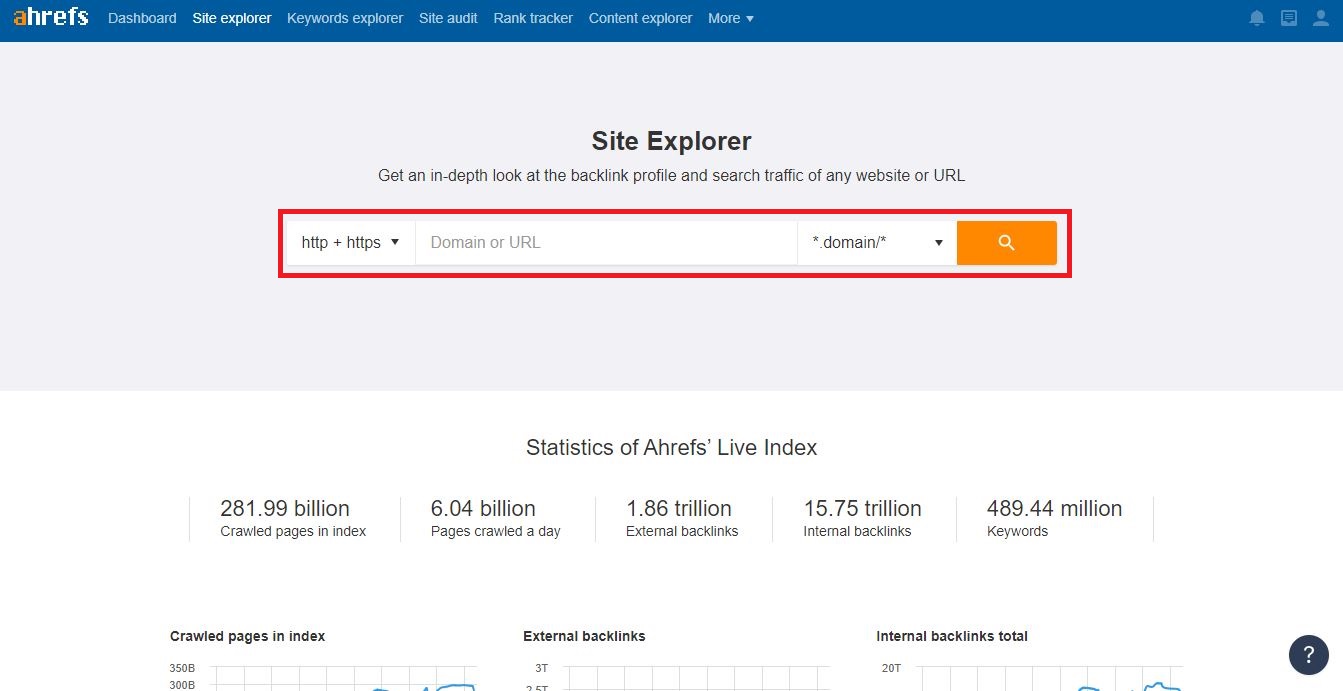

Now on this page, you can see everything from Alexa Rank to UR, DR, backlinks, referring domains, organic keywords that the website is ranking for, total organic traffic (monthly), along with the CPC based value of that traffic.
A simple and sorted solution, right?
Make sure you count this in for your host blog hunting process.
As internet users, we’ve all seen a variety of website layouts and designs.
Yes, some of them are totally brilliant. They have all the elements in the right places. Easy navigation. Smooth layout and flow. Great look and feel. And they look genuinely into the niche.

But is that the case with all websites? Uh no!
In your pursuit for finding the right blogs for guest posting, you may come across a number of
websites that may not look and feel right.
Sometimes this can be for the flood of ads that they may have. Sometimes a slow loading interface can be the reason. Sometimes the website may lack responsiveness. And sometimes it may just be an unpleasant design.
Also, there can be websites that look like they are meant for nothing but guest posting.
Our aim is to steer clear of such websites. They can be a waste of your content, hard-earned money and precious time.
And here’s another metric on the list.
The world of digital marketers knows about Alexa rank. A global factor that helps marketers identify the credibility, backlink strength and traffic quality on a website. It totally makes the cut to be a factor for you to decide whether a site is worth your guest post or not.

So, count this one in and check a website’s Alexa rank before guest blogging on it.
Tools like Ahrefs can help you identify Alexa rank of any website on the web. We talked about the same in section 1.3.7.
As mentioned in section 1.2, guest blogging helps marketers improve their social media presence by giving them exposure to the blogger’s social media audience.

This is a significant benefit that you may not want to miss out on. So, make sure you consider the social following of the blogs or websites that you are exploring for guest posting opportunities.
If a blogger has a rich social media following, chances of your content reaching more people will
automatically rise up.
While guest posting is one of the best link building techniques in the world, the state in 2020 is such that it has now become a mere business for many blog owners.
And we know, where there’s greed, there’s potential for fraud, even in guest posting.
So, how’s it happening?

Well, breaking it down to you, bloggers know that many marketers prefer website traffic and Alexa rank over other factors while choosing blogs to guest post on. But then, boosting Alexa rank isn’t
child’s play. So, what do they do?
Well, there’s one small loophole that we may get to acknowledge from time-to-time. And they
make use of it.
By pasting their google analytic tracking code twice in their website’s ‘header.php’ file, they are able to manipulate analytics traffic stats.
This means that for every 100 visitors, analytics shows 200. For every 1,000 visitors, analytics shows 2,000. For every 1,00,000 visitors, analytics shows 2,00,000. Such fantastic stats, right?
Well, that’s fraud, and many marketers fall for it.
So, how can we keep safe? It’s simple. Ever heard about ‘source code’? Here are the steps.

This is an example screenshot and not taken from a real scenario. Source code pages don’t look like this.
If the searched term appears multiple times (as in the screenshot above), it’s time for you to move on to another guest blogging prospect, as things may be ‘really’ fishy here.
Pretty smart, right? Well, that’s how it’s becoming a business, and that’s why we need to pay attention.
In chapter 1, we’ve had an introduction about guest posting. We read about its benefits, and we learned about how we can choose between multiple guest posting opportunities that we may have.
But what’s the point if we don’t know how to find those guest posting opportunities in the first place?
That’s what chapter 2 is about.
Here we’ll discuss finding highly qualified and relevant guest posting targets. So, let’s go.
The holy grail of link building for over a decade, Google search strings never fail to perform.
Talk of reference links from 2013, search strings used to work wonders with that. Talk of blog commenting from 2015, search strings used to work wonders with that too. Talk of guest posting in 2010 or in 2020, Google search strings can be of great use for that as well.
But how does the idea work?
Well, search strings are just like general formulas for finding ultra-specific content on Google.
For example, one of the most popular guest posting search strings on Google is “Keyword” + “guest post”.
Now, assuming that we are using this search string to find guest posting opportunities for the keyword
AR VR, we can search Google for “AR VR” + “guest post”.

As it’s visible, our search for the term “AR VR” + “guest post” showed several websites offering guest
posting opportunities.
And there are hundreds of such search strings that can shower you with a world of relevant guest posting opportunities. For starters, a few of them are as follows.
While finding qualified guest blogging websites on Google can be a laborious task, these search strings make it easier than ever.
If you use Google every day, the chances are that you might as well know about Google Image Search.
Talk of reference links from 2013, search strings used to work wonders with that. Talk of blog commenting from 2015, search strings used to work wonders with that too. Talk of guest posting in 2010 or in 2020, Google search strings can be of great use for that as well.

Yes, we are talking about the section in the red box. This is the feature that allows web users to find images relating to any search term that they search Google with.
But that isn’t reverse image search, so, what is it? And how can it help us find guest posting opportunities?
Stay with us here.
Reverse image search is just what its name suggests — the exact opposite of image search.

So, you search the web with an image, and it shows you all the web pages where that image can be found.
And how to use this for your benefit?
Well, if you (or your brand) ever created an image and published it on the web, there’s a high probability that this image may be present on another web page without your consent,
And that’s where you can request a backlink/credit for the image that you created.
Speaking of which of the images should you start with, consider the ones that are a part of your most
popular web pages (you can easily identify your most popular web pages in Google Analytics).
Twitter is one of the most popular digital marketing platforms in 2020 and everyone knows about it.

But is it only great for distributing content? If smartly used, Twitter can become a gold mine of qualified guest posting resources for any marker on the planet.
Speaking of which of the images should you start with, consider the ones that are a part of your most
popular web pages (you can easily identify your most popular web pages in Google Analytics).
The most straightforward way of finding guest posting opportunities on Twitter is by looking for them.
Yes, it may sound a little too vague to start with. But don’t worry. We’ll remove ambiguities.
In the first step you just have to make a basic search for the terms “guest post” or “guest author”.
This search will present you with all the tweets including these terms; even if the terms occur in the URL(s).
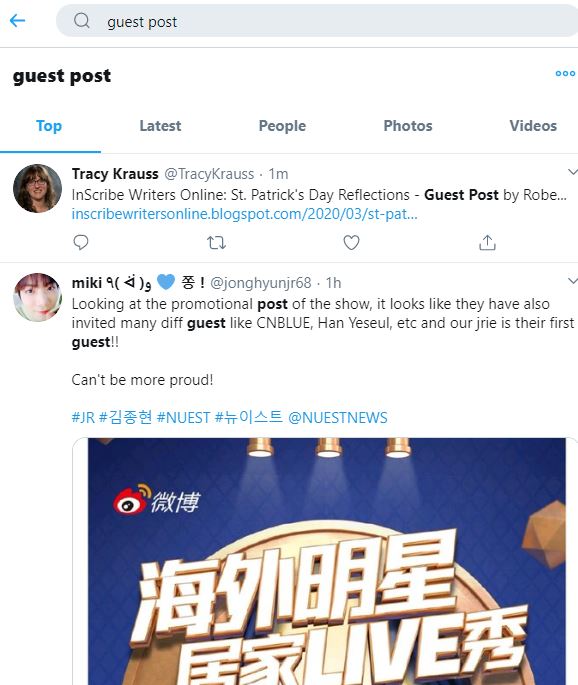
But, there’s one small challenge.
Such searches can be vague and may bring up a flood of guest posting tweets that may be irrelevant to you.
So, how to weed out?
Well, adding a keyword related to the niche can help.
For example, if you are looking for guest posting opportunities in and around the SEO niche, you can
search for “guest post” SEO.
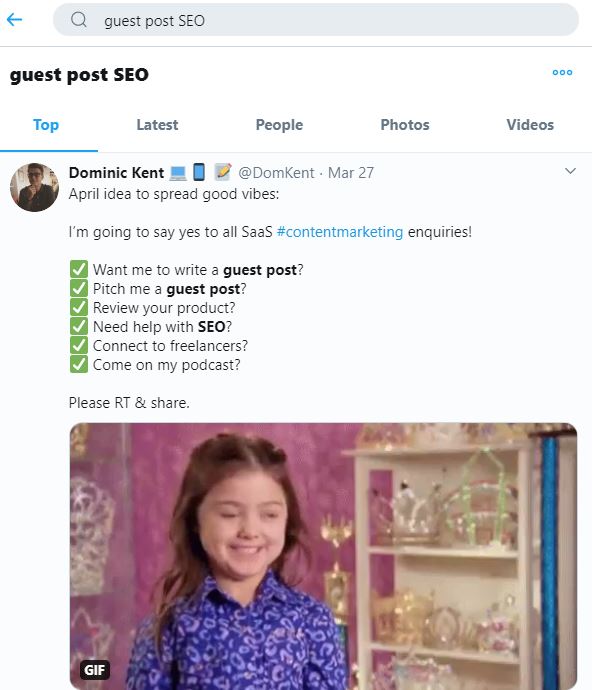
The results will have a comparatively thinner list of relevant guest posting prospects that’ll be more
relevant for your niche.
The most straightforward way of finding guest posting opportunities on Twitter is by looking for them.
Yes, it may sound a little too vague to start with. But don’t worry. We’ll remove ambiguities.
In the first step you just have to make a basic search for the terms “guest post” or “guest author”.
This search will present you with all the tweets including these terms; even if the terms occur in the URL(s).
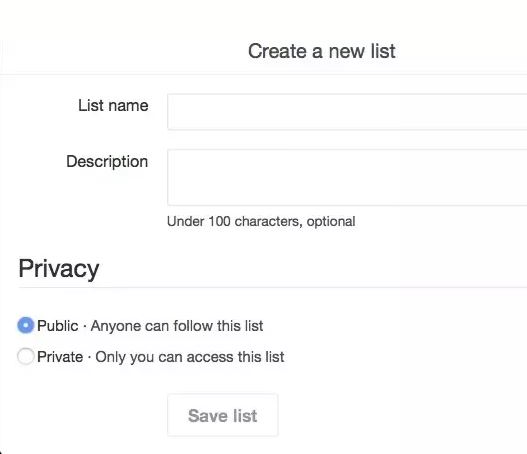
This way, you’ll be able to access these guest posting websites whenever you feel the need. Plus
you’ll also be able to sort/categorise different guest posting websites on the basis of their niches or microniches.
RSS feed is one of the simplest ways of keeping up with a blog or website. In fact, that’s what it’s
most popular for.
But is that all about the use?
Well, not many people know, but RSS feed can be used for exploring guest posting opportunities as well.
To start, you can use the following service for creating RSS Twitter feeds:
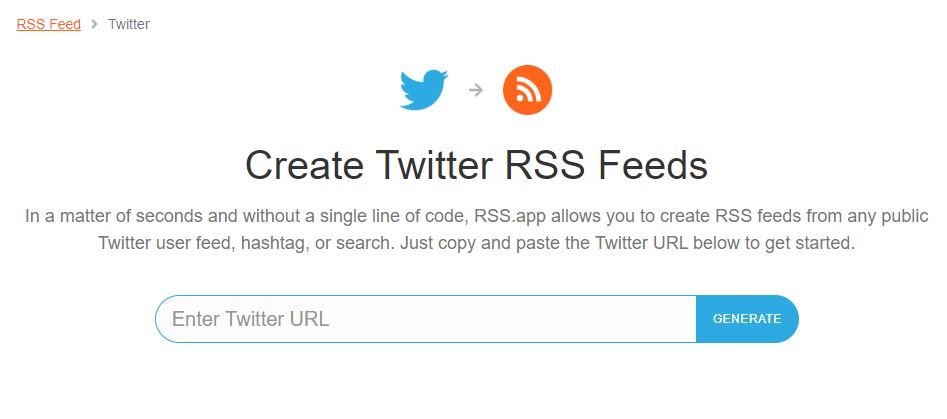
Source
Now all you need to do is keep yourself updated with this URL.
And here comes a straightforward way of building backlinks — tracing your competitor’s footsteps.

One of the best and the worst SEO facts about websites on the web is that every action they make
leaves footprints.
And these footprints help their competitors track them. That’s what makes the deal bad for them and
good for their competitors.
In this section, we are talking about the good that we can reap from these footprints.
All you need to do is start off with a backlink research tool like Ahrefs. This will enable you to trace your competitors’ backlinks. And the next step? Well, now you can do anything with this information.

For example, you can write a ten times better post than your competitor and propose the linking website an offer to replace the link (it may not work 100% of times, but even one link is better than none).
Or you can simply use this info for creating more and more qualified and relevant guest posting opportunities. In both ways, you’ll be equipping your SEO arsenal.
On your hunt for finding qualified guest posting blogs, you may often feel the need for having a tool
that would list all the best blogs in your niche.
And that’s right when you use alltop.com.
Yes, it’s a platform that can present before you a world of highly qualified guest posting blogs and
websites that are relevant to your niche.
So, wait no more. Head right on to alltop.com and search for your topic. You’ll find a rich list of
qualified blogs that’ll be relevant to your niche.

Yes, you may not be able to publish a guest post on every single blog that you find here, but you can
still pull off a good backlink profile through Alltop.com.
Another hot-shot idea for finding tons of qualified guest posting websites is by following the prolific guest bloggers in your industry.
If you’ve been around in your niche for a while now, you might have come across the names of some
bloggers who are actively publishing/guest blogging on many websites.

One great thing about these prolific bloggers is that they don’t create content for weak blogs (obviously, their content is worth its weight in gold). This is why if you can manage to find websites that these prolific bloggers are publishing their guest posts on, you’ll have a thick list of qualified websites that you too can guest post on.
And it’s a simple process. All you need to do is make a Google search for prolific bloggers in your
particular niche. You can also use the search term “guest post by” as a prefix.
Yes, we’ve already talked about how you can look for and find myriads of guest posting opportunities on Twitter. It works great for many people, and it can work wonders for you as well.
But Twitter is not the end of the social media realm. And so, social media in 2020 has a sea of guest
posting opportunities that you can explore.
All you need to do is be active on social media networks that are most popular in your niche and are used by your guest posting prospects.

For example, Linked In is the perfect professional space where you can find many bloggers and
webmasters in your niche, allowing guest posts on their websites.
Whether it’s to build direct links or to explore guest posting opportunities, blog comments have always helped SEOs win the deal.
So, if your blog has a fair audience base and gets comments from them, you may be in luck as many times these comments can lead you to new guest posting opportunities.
How does it work?
Well, if a blog or website owner leaves a comment with their website link, it may be an indication that they want you to check their work out.
This can help them build a relationship with you. Plus, this relationship can help you build a guest posting partnership with them.
So, whenever you get comments with a relevant website link, make sure you take the conversation ahead with a sweet and genuine response.
Moving further here’s an easy way of finding blogs and websites that you can guest post on.
Just scan the lists of sites that accept guest posts.
The Google SERPs are brimmed to the top with results showing websites that offer free guest posts. Surely there are at least a thousand of them.
So, yes, none of us can throw weak excuses saying that we couldn’t find a website for guest posting.
For reference, here are a few such websites
When you are looking for guest posting opportunities in your closed niche, you may come across websites that are your direct competitors.
Yes, you would certainly exclude them from the campaign. But this will also mean that you’ll have fewer guest blogging prospects.
So, what to do?
Well, that’s where shoulder niches may come in handy.

It’s true. If you laser target your guest posting efforts only around one specific niche, you may soon run out of options.
Exploring shoulder niches/market overlaps will keep that from happening as the blogs and websites in your shoulder niches will have relevance towards your content and hardly any market overlaps — which means that you won’t have to partner with your competitors.
So, stop looking for guest posting opportunities related to only a single keyword or niche. Instead, explore neighbouring niches that aren’t too closely related to your niche, but still relevant.
When you are friends with a blog owner or marketer, collaborating with them becomes easier.
Well, in the previous chapters, we learned about how trust can help you bag your desired guest posting
opportunities. Being friends with marketers and blog owners does just the same.
It evokes a sense of trust in the mind of your new friend(s). Plus, they may also get a good idea about your business, brand and blog, so they’d already know quite a lot about it when you present your pitch.

Makes sense, right?
Finding qualified and relevant guest posting websites is super crucial for your link building campaign.
In this chapter, we talked about some of the most effective techniques for finding host blogs that have helped DWS build a database of nearly 50,000 qualified guest posting websites with qualified web traffic.
Now, we are offering access to all these websites to our agency partners through our enterprise resource planning (ERP) software CollabX.
Clearly, all your above efforts can be completely removed by signing up with us.
Moving further, in chapter 3 we’ll learn about the next step; preparing the perfect pitch.
Once you’ve found yourself a wholesome list of websites to guest post on, it’s time for you to prepare
a pitch.
An email with all the best words, sentences, and phrases that can finally get you to have your post live on that traffic-rich website.
And the challenge? It’s somebody else’s website, and you need to convince them before they accept
your offer.
Yes, the situation can get the best in sweat.
But don’t worry. That’s what this chapter is entirely about. Here we are talking about how you can prepare a high-converting guest posting pitch that your prospects will consider.
Ready with your list? Well, it’s time to prepare a pitch. And where do we start that? With learning a little bit about the host blog.

Even though this blog is related to your niche (we shortlisted relevant blogs in the previous chapter,
right?), some amount of research still needs to be done. And to make it easy for you, here’s the research that you must do about the blog that you are going to pitch your guest post to.
To make sure that the guest post that you write gels well on the host blog and connects adequately
with the audience, you must note the characteristics of other blog posts that are already on this blog.

This will give you an idea of the language that the blogger uses. You will learn about the type of
content that the audience likes. You may also get to know about how the audience reacts in
comments and the types of titles, images, slangs and everything else that the blog owner uses.
As a result, you’ll have the right knowledge about the blog and what type of content may work
best for it.
The second step that you need to follow is to look around and find out how the other guest posts are
working on this blog and its environment.
The blog may have any number of guest posts starting from zero. So, if we are in a no-guest-post region (blog), we may skip this part.
However, if there’s even a single guest post, make sure you go through it and analyze its content, traffic stats (we talked about Ahrefs, right? That’ll help you), comments that it’s getting, the total number of shares that it has received and every other metric that matters.
Also, if there are multiple guest posts, and if some of them are performing better than the others, take note of the factors that distinguish high performers from the rest.
This will help you while writing your guest post.

When it comes to trusting others, we all prefer planting our faith in people who we know or have any sort of relation to.
The same holds true for your prospect blog host as well. And that’s one reason why it’s important for you to check out the other guest bloggers on this host blog.
Think about it. Finding a fellow blogger, freelancer or general content creator publishing a guest post on this blog will mean that you can talk to them and see if they are okay with you using their name for a small reference while proposing your pitch.
This will help the blog owner develop trust towards your proposal, so the chances of them saying yes
boost up.
As already mentioned, it’s important for you to find out the type of guest posts that work the best on the blogs that you are considering for outreach.
This will make you aware of the type of content that’s relevant and generally appreciated by the blogger and his/her audience.
Speaking of how to find out which guest post is working better, you can use Ahrefs, and the following other tools well.
Most of the qualified blogs and websites that you come across will have a set of guidelines that must be followed before you write the guest post.

And yes, these guidelines will vary from blog to blog and website to website. So, before you prepare your pitch, go through the guidelines and find out what exactly is required of you and the content that you are to submit.
In some cases, you may not even have to write the guest post, but only suggest the topics. And in some
cases, you may have to think of a topic, write the guest post and pay the blogger an amount of money
as a generous compensation.
Yes, possibilities are many, and to find out about them, you must go through the guidelines.
So, it’s time to personalize your pitch. Yes, this piece of content is going to be the one that decides whether your next email is going to be for follow up or for submitting your guest post.
Sounds crucial? Well, let’s make sure that we do it right.
Here are a few tips that you can use for writing guest post pitches that convert.
So, the first thing to do – introducing who you are.

As already mentioned in this post, many bloggers only allow guest posts from creators that they know. his means that if you are in touch with a blogger who has already posted on this particular blog, you should try to seek permission for using this reference.
Also, it’s great to establish your identity at the start of an email pitch, so the reader knows about your authenticity. Apart from this, make sure you talk about your blogging qualities as well.
Did the analysis in the last section? It’s time to make use of it.
As you are going to approach a blogger for allowing you to publish a guest post on his/her blog, it’s
crucial to offer enough value. And how can you prove this worth in just an email?
Well, suggesting a few relevant guest post titles is a good way to start.
Take this, for example.
If you are planning to approach a blogger that talks about SEO and digital marketing, you may let
them choose from the following titles.
It’s 2020, and the world demands social proof for most things.

you would know how testimonials work, right? Well, this is nearly the same thing. By showcasing your
previous work (guest posts), you will be assuring the host blogger that you provide qualified guest posts that perform and are appreciated.
This will obviously add to your credibility and will surely be considered by the host blogger.
Next thing to do – tell them why they should consider your proposal.

Yes, this is where you can boast off a little. So, whether you are the king of unique guest posting ideas or have a super attractive writing style or are capable of creating share-worthy infographics, this is the time to talk about those qualities.
Also, don’t go over the top and make sure that you mention a clear purpose behind your willingness
to submit a guest post on this particular blog.
Take this for a fact, nobody likes partnering with people that are rude or insensitive about the words
that they use.
This is one reason why it becomes more crucial to be kind and courteous while writing your email
pitch. Remember, if you give respect, you get it back too.
One of the most important things to keep in mind while writing an email pitch is to be concise.
The blog hosts aren’t going to appreciate receiving your entire guest post in your pitch. Instead, a
short and to the point email pitch may work way better.

So, ensure the use of warm words like, “please”, “regards” and “thank you” and just keep it concise.
That’ll be the perfect balance of warm and crisp.
And after you’ve done it all, proofread your pitch. Share it with your partner(s) or friend(s) for
suggestions and when it seems good to go, SHOOT and start planning your follow up email.
For a better idea, here are some examples that you can refer to.
Hey, [name]!
Your [choose whatever service or product you want] is amazing! I’ve forwarded it to a few of my contacts who I think could benefit from your [product or services].
When I was looking at your site, though, I noticed an error. It’s a relatively simple fix.
Would you like me to write it up so that you can share it with your web team? If this is a priority, I can also get on a call.
Regards,
[Your name and title]
Ahoy ___!
My name is ___., I’m an adventure loving traveller from Sydney. I have worked in the travel industry as a freelance alternative Sydney tour guide for more than four years. I’m also a blogger/editor at ___.
I travel a lot and I’m trying to gain some exposure as a writer, and your travel section seemed like the perfect section for my future article. Here are some titles that I’m working on right now.
– Idea 1
– Idea 2
– Idea 3
– Idea 4
I really hope you like the ideas and contact me if you are interested in having my guest article on
your blog! I would love to be a part of your fab online space.
Oh, and here are some stories that I’ve written recently so you can check them out if you like the
way I write.
P.S. I love Ireland, have visited Dublin and the cliffs of Moher in 2014 and am still remembering every single detail about the trip (especially Guinness, lol)
Would you like me to write it up so that you can share it with your web team? If this is a priority, I can also get on a call.
Cheers,
In a number of cases, you may have to have a tough time finding email addresses of the host blog.
And then some blogs require you to fill out contact forms to get in touch with them.
But don’t worry. If situations like those occur, the following tools will help you.
If you’ve ever tried finding guest posting opportunities you may know how some websites don’t put
their email address on display. And then, some of them don’t even have a contact form.
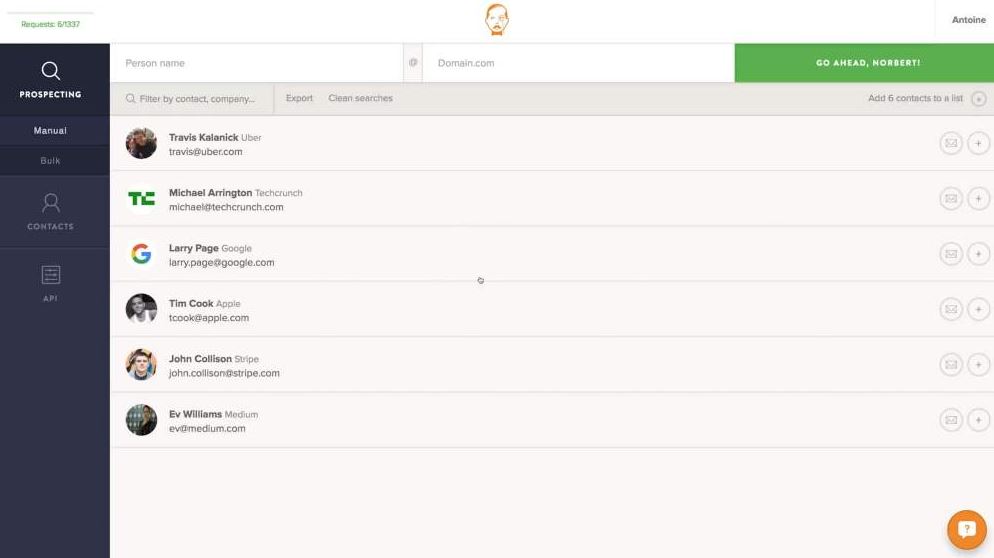
But as we need to approach them with our pitch, we can surely go a step further, right?
Tools like VoilaNorbert and Rapportive can help us do that.
In fact, the brand title of VoilaNorbert says “Find Anyone’s Email Address”, and then, it helps do
the same.
Many websites that you may approach with your guest posting proposal may not have an email address on display, but a contact form.
And that’s not the problem. We know how to fill out these forms. The question is how to do it when
there are too many of them?
You’d know how filling out the same details on different websites, multiple times throughout the day
can be a laborious task. That’s why we use tools like TextExpander.
What TextExpander does is let you easily fill contact forms on websites and blogs that you want to guest post on.
Basically, all you’ll need to do is tab through the form fields, and it’ll fetch your details automatically.
Sounds exciting? Have a look at how it works.

Source
Smooth, right? Well, it indeed is a great time saver.
Once your outreach campaign starts flowing in full swing, you may require to send a lot of emails.
And when we say so many, we refer to a number where Gmail’s daily limit (2,000) is reached.
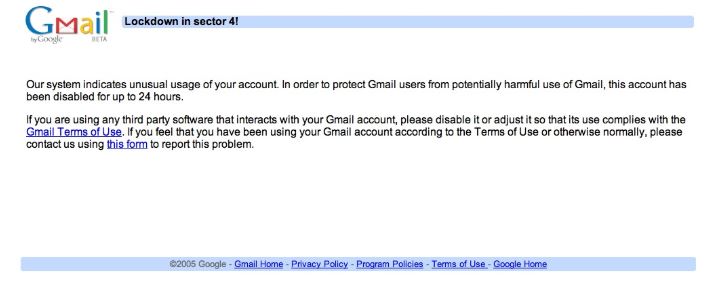
Now, if this happens, you won’t be able to access your gmail account for another 24 hours, which will
mean that your campaign will suffer.
Thanks to Google Apps for saving the day.
Yes, if you are registered with Google Apps for Work, you can send a total of 10,000 emails in a day.
So, if you are scared that your sending limit may soon be touched, you must secure your campaign’s
progress by switching to Google Apps for Work.
Coming to how you can get started, it’s an easy sign up process and we have mentioned it below.
Did you know that only around 9% of email pitches are opened in the first go?
Well, yes. The chances are that the first enticing pitch that you sent has gone unnoticed by the blog host. But thankfully, that’s not the end of the world.
Not getting a response doesn’t always mean ignorance.
Sometimes your email may generally get lost in the receiver’s inbox. And sometimes, the receiver may plan on getting back to your email but forget for one reason or another.
Clearly, that can be rectified; by following up. However, it is a possibility that you are sending messages to the wrong email address. In that case, use a reverse email lookup tool to find out if the email address belongs to the person you have been meaning to reach.
With that out of the way, let’s find out how to follow up on your emails the right way.
Well, it’s a fact. If a person takes copywriting and content creation seriously and is authorized to judge quality, they may judge your pitch and follow up email for every single word.
Result? If your pitch doesn’t sync well with their mind, they may get rid of it (delete it).
And then, if your follow up email follows the mistakes made in your pitch, your email address may get
labelled as SPAM! This means, no further emails from you will reach this blog host.
So, what’s the solution?

Make sure you don’t send a myriad of follow up emails.
In fact, it’s best not to send more than a total of two emails, one for your pitch and the other one for follow up.
Let’s imagine a scenario.
Someone sent you a guest posting pitch that you read and didn’t find appealing. That’s fine. You move on from it. But the person who sent that pitch doesn’t, so he/she sends (or attempts to send) a follow up email which comes to you like a new email.
Now you, who has moved on from the first pitch, may or may not be able to remember hearing from this person.

Avoid this practice. Send your follow up emails in the same thread as your pitch, and you may get luckier than the last time.
Follow up emails that are too short may lack the crucial pointers that must be covered in the email.
While follow up emails that are too wordy may take a whole lotta time for the receiver to go through.
And the end result in both cases is the same.
The blog host may simply choose to ignore your follow up email (just as they might have reacted to your pitch).
In most of the cases, you’ll have lost this guest posting opportunity for a long time (at least until the receiver forgets about you and you approach from a different email address).
So, keep it short, and to the point. The aim is to make sure that most of the words that you write are read. Apart from this, make sure it’s mobile friendly as more than half of the emails are opened on mobile devices.

Also, don’t forget to leave your signature in the end and push the mail ahead.
Like any other marketing content, emails also have peak performance hours.
Basically, if your follow up emails are reaching the blog host after 2 PM, they may choose to stall it till the next morning. And by that time, your email will have been trampled under a bunch of other emails.
So, what to do?
Well, one simple solution is to make sure that you send your follow up emails before noon.
The reason why it works the best is that in the morning, the editors will be able to look at your follow up in a positive mood and fresh mind. They’ll not be in the hurry of leaving for their homes. They’ll not take your follow up as an unnecessary burden on their desk.
The following graphic provides a subtle elaboration for the same.

Source
This will boost the chances of your sweet and concise follow up email being considered by the blog host.
As it may be clear from the previous pointer, the timing of your follow up is crucial.
But that was about the best time of the day. What about when exactly should you send it?
Basically, being impatient won’t help here. So, if you’ve been planning on sending the follow up email three or four days after mailing your pitch, you may be failing.
And the exact results of this impatience can’t even be anticipated.
“So, when should I send a follow up?”
Well, the best place to look for an answer to this question is the host blog itself.
Remember the guidelines page? In most cases, this page will have details about when you should follow up.
Here are some of the most common follow up guidelines that you may come across.

Source
This will just imply that you are polite and not impatient.
One of the most curious questions that every marketer seeks an answer to i — has the blogger even opened my pitch?
Well, thankfully, we live in a world that’s adequately equipped with several tools that notify us about it.
How about using these for your guest posting campaign?
Mixmax and Mailtrack are two of the most useful tools that can help you here.
Source
You get the point? Following up without disturbing the blog host is an art less mastered, but we must all work towards getting better at it.
When you are sending outreach emails to a large number of guest posting prospects, the task of managing details can get you in sweat.
That’s where tools like Yesware and Mailchimp make life easier.

They allow users to easily create, send, manage and track multiple outreach campaigns at ease, in a few clicks.
Plus, they can be synced with Gmail (or Google Business Apps) and Office 365 if you opt for the premium and enterprise plans.
Also, the pricing is reasonable, and the tools are super easy to comprehend and use.
In the last chapter, we learnt how to write and send high-converting outreach emails to our guest posting prospects. Surely it’s an achievement to be able to convince bloggers to allow a guest post on their website. But is that the end of all challenges?
Not that writing a guest post is that much of a challenge. However, it may simply be turned down if it doesn’t seem to add value to the blog.
That’s why it’s super-crucial to create qualified guest posts that fit best for the prospect blog and your target page as well.
And in this chapter, we are talking about that. Here’s how you can write one legend of a guest post that the bloggers and their audiences will love.
Coming to the second part, it’s super important to smartly research keywords before writing your guest post.

This will make sure that your guest post is able to target the audience base that you want to target. Also, the right keywords will help your guest post rank better in the search engine, delivering rich link juice to the backlink(s) that you are going to build.
So, what’s the right way for researching keywords? Here are a few simple steps that you can follow
You can’t find important keywords regarding a topic until you know what the topic is.
For this reason, it’s crucial to start with shortlisting important topics before actually dwelling into keyword research.
So, think about the topics that you want to rank for. Topics that are popular in your niche. Topics that will best suit the blog that you are planning to guest post on. Topics that can subtly support your anchor (the keyword that you are going to build your link around).

Also note that, sometimes the topics may be provided by the blogger or who-so-ever handles guest posting for that particular blog/website.
In cases like these you can skip this step and directly move to the next one.
Now that you have a list of topics that you want to target, start looking for keywords that best fit these topics.
For your ease, you can start with considering these topics as different categories and then find keywords for them.
Now comes the big question: HOW?
Well, this is where Ahrefs comes into play.
To start with, make a Google search with your topic and check out the search results. Pick two or three of these links and feed them in the Ahrefs’ “Site Explorer”.

This will take you to the results page which will look like this.

What you need to do here is click on the tab for organic keywords, and you’ll be able to see all the keywords that this particular URL is ranking for. Super easy + super effective
Once you reach this Ahrefs page with all these organic keywords, it’s time for you to sort these keywords on the basis of your priority and intent.
Speaking of the demographics that you can sort them upon, here’s the list.
Coming to intent, it’s more of a human thing. Basically, an algorithm can’t tell the best about it.So, if you are looking for keywords for targeting prospects in the final stage of the conversion funnel, you’ll have to know your niche better and the terms that your final stage prospects are most likely to use.

Ever noticed those blue-bold search phrases at the end of a Google search result?
Yes, we are talking about them.
While it’s essential to include the main keyword in your content and be relevant around it, you must also include these related search terms and talk about them.
This will benefit you in two ways.
Every piece of content that leaves your desk needs to have a stunning headline.

And it’s not just about sounding nice. The idea is to make an impact. Caste an impression. Convey a message that compels your audience to move beyond the heading and to actually consume your content.
he same holds for your guest post as well. Although you can always have the option of improvising later, it’s better to have a beta version of your headline before you start writing your guest post.
This will give you the right direction that you need for writing the guest post.
Coming to how you can create a great headline, here are the tips.
Yes, you may or may not choose to use numbers in your headline (not everyone likes the idea of including stats or writing listicles). But what if we told you that using numbers in your headlines can generate up to 73% more social shares.
The reason is simple. By including a number, you can indicate your surety around a subject.

It’s like you’re not vague. Instead, you are confident about the number that you have included in your headline.This confidence is generally appreciated and looked up to.
It’s 2020, and no one has time for stuff that doesn’t benefit them.
Clearly, if a visitor comes to your website and opts in for reading a blog post, that’s because they believe that this blog post will benefit them.
But how can you convey the benefit before they even read the guest post written by you?
Well, the right headline can do wonders for you. All you need to do is give your readers a good reason to click through your headline and read the guest post.
Giving a good reason to click through means talking to them about the benefits that they’ll get after
clicking through, basically, how your content is going to help them.
For your better understanding, here’s a list of rationales that you can use.
And the possibilities are endless. Just make sure your headline doesn’t promise something that you aren’t offering and still is compelling.
In a general scenario, the human eye and brain only notice the first three and the last three words of a headline in the first go.

This means that if your headline has twenty words, fourteen connectors in the middle may not get the right amount of attention.As a result, your message may not be conveyed properly, and your readers may not be willing to click through.
So, what’s the first lesson that we take from this?
Don’t overextend your headlines. Yes, you may feel the need to mention more, but what’s the point if your readers have to go through the title twice?
You can surely save your readers’ time and acquire their attention by keeping your headlines under a short word limit.
Studies suggest that the best English headlines have no more than 16 to 18 words.
If you succeed at evoking the right emotions in the minds of your reades, you can surely get them to click through your headline.
Yes, we’ve all come across headlines talking about how “fantastic” or “amazing” the 9 mentioned tips are. And it works because these words evoke an emotion that the readers can relate to.

Take this for example. A headline like “7 Simple Tips For Creating a Website Free of Cost” can evoke multiple emotions in the readers’ minds.
It’s like if someone wants to build a website but is on a tight budget, they’d most probably click
through for the phrase “Free of Cost”. Apart from this, the word “Simple” means that the readers will
not have to have a tough time, which is another reason why they may click through.
For reference, here’s a list of some emotional words that you can use in your headlines.
Every content creator has a way of writing. A flow that they follow. A formula that they mostly work around.
This doesn’t particularly mean that they are overly strict about it. However, this formula makes content creation easier.
The same holds while creating headlines.
Take this for example.

Well, this image is really worth a thousand words. It easily breaks down a general formula for writing stunning headlines. And then, there are many other similar formulas that you can create and/or follow.
For a fair idea, here’s what Lars Lofgren says about creating headlines:
Okay, so when we say link appropriately, it’s not just about planting your target page’s link in the guest post.
Yes, that’s crucial. However, you must also make sure that you add relevant outbound links wherever needed, along with inbound links to the other pieces on the blogger’s website.
This will help you establish a better relationship with the blogger. Plus, it’ll boost the odds of your guest post for ranking in the SERPs (yes, inbound and outbound links matter that much).

Speaking of what we mean by appropriate linking, make sure that the links that you add don’t come off as salesy or redundant.
Understand that the purpose of this guest post isn’t to build a backlink to your site, but to provide useful information to the blogger’s and your audience.
So, plant it in a subtle manner and don’t overuse the same anchor texts (that’s bad for SEO).
Without saying, visuals are essential for all blog posts that you publish.

Readers connect incredibly with images and videos. They can relate to them. They can retain them. They can enjoy consuming them, and visuals surely make huge text blocks more attractive than they could ever be.
Clearly, you would include images and other visual pieces in a blog post that would go live on your blog, right? Plus, you may expect the guest blogger for your blog to provide relevant images. So, why not deliver what we expect to receive?
Make sure you include high quality, relevant images/videos in all the guest posts that you ever write.
This is a way of being respectful to the blogger, their blog, audience and to the guest post that you are writing as well.
Note that the idea is to treat every guest post as a blog post for your own blog.
Many times we come across blog posts that are way too random with their content. With no flow. With a poor structure. And a visibly weak planning.
And no matter how well they are written, with such an ‘all over the place’ kind of format, they still fail to perform as nobody has the time for analysing too much.

It’s true, your readers are not going to spend time arranging your bits and pieces of useful information. It’s not their job, but ours. So, we must make sure that the guest post that we write has a clean format with a smooth flow which makes the content easily comprehensible.
But how can we do that? Well, here are a few tips that can help.
We don’t even need to leave the page for examples. This single chapter has 25 subheadings and over a hundred paragraph breaks. That’s one reason why you’ve been able to read through the above piece and reach till this point.
Otherwise, with no subheadings and way fewer paragraph breaks, this chapter would have looked like this.

So, we may not say that it s*cks. But surely, it’s not the most convenient and comprehensive way of transferring information.
This is the reason why we emphasize structuring using subheadings and paragraph breaks.
After you’ve learnt about the importance of dividing your guest post with subheadings and breaks, you should make sure that your post is aligned correctly.
In simpler words and with a shorter story, the point is to keep a limit on how wide you want your post
to be. The idea is to maintain a balance of narrow and wide.
Annabel Candy suggests an 80 characters width. For a better understanding, you can refer to the image below.

Source
Lists > Paragraphs; anyday.
The reason is that they are more concise, sharper, crispier and spot on. They don’t include much fluff. They come directly to the point and so they take less time to go through and less effort to understand.

Also, they make your content look good by adding an element of slight structural variation that’s appealing to the eye and the reader’s mind as well.
So, make sure you prioritise lists over paragraphs whenever you can.
We know about different subheaders namely H1, H2, H3, H4 and so on.
Clearly they have a purpose to fulfill. They are different in size and so they can be used for different reasons.
For example, in this very chapter, the first heading, i.e., H1 says “Chapter 5: Write Your Guest Post”.
The second heading (which is a subheading to the first one), i.e., H2 says “4.1 Research Keyword Phrases”.
And then, the third heading (which is a subheading to the second one), i.e., H3 says “I. Shortlist Important Topics”.
This is one way of using different heading tags (H1, H2, H3 etc).
During your guest posting campaign you may come across several blogs that may allow you to provide an author bio that’ll be placed at the end of the post.
This is the perfect opportunity for you to talk about yourself, your brand and website (yes, there’ll be websites that’ll only accept your link if it’s in the author bio and then there’ll be websites that’ll allow a link in author bio and another one in the guest post).

So, how to make the most out of this opportunity?
Follow these steps and you’ll sail smoothly.
Now this doesn’t have to be too much about your personal life. Yes, you may mention a recreational hobby or two. Apart from that, this introduction has to be about your professional occupation.
And don’t forget to include your title and company name. These two are most important.
You may also be asked to provide a picture of you. Just make sure it describes you and is of high resolution.
Include only the most essential information. Don’t write too much. Keep your author bio short as not
everyone is going to be interested in reading a lot. However, if you keep it concise, the chances of
your complete copy being read will dramatically boost up.
Recommended author bio word limit is 75 words.
Another thing to keep in mind — it’s better to write your author bio as if someone else was writing it
for you.
This is just to create some gravity around your designation. Also, this is not for your own blog, so talking in the first person may not make much sense.
As already mentioned in this chapter, it’s recommendable to use a variety of anchor texts in your guest posts. The reason is that using the same anchor text over and over can turn into an invitation to a search engine penalty.
This is why you must submit your author bio with different anchor texts for different blogs.
So, keep this in mind.
here can be times when you or the blog host may not want to place many links in the post. But then, credit should be given where it’s due, plus, if you take references from a website or web page, it’s your duty to cite it.
So, if cases like these occur, you can create a “resources” section at the end of your guest post and paste all the reference links here.

This will deliver credits to the blogs and websites that you took reference from and the blogger also may not have an objection with this.
So, finally, your guest post is live. Yayyy! Now you have a new backlink and maybe a wider audience. Ahan, really?
Well, that may be the case, but do our efforts end there?
Remember, in chapter five; we talked about treating all guest posts as blog posts for your own blog? Yes, we are just going to do the same.
Distributing this guest post across different social media channels. Promoting through email. Building tier links and even talking out loud about this collaboration of ours. Surely this is going to be fun.
So, let’s do it.
Your company/blog may be active across various social media channels where you may share all the
important information and details with your audience.
Why not use these platforms for promoting this guest post that you just wrote?
Think about it. Being vocal about this collaboration will boost your audience’s credibility towards your brand. It’ll make them realize that your brand’s quality is being validated by other niche players as well.

Also, these social shares and the engagement that they reap will be beneficial for this guest post’s search performance.
Just remember that blog posts work the best on social media if:
Moreover, by sharing the guest posts written by you and by talking about all the other collaborations that you may be indulging in, you are anyway working towards building credibility and establishing your authority.
Backlinks are crucial for all content pieces to perform in the search engine. This doesn’t mean that no web page can ever rank without backlinks. However, backlinks provide a more sustainable rank in the search engine, and that’s why we emphasize on building links for our blogs and websites.
But what about our guest post that just got live?
Yes, the blog owner may work on giving links to it. Yes, they may work towards a smart distribution. But we can’t rely 100% on what they may do.
In fact, it’ll be best if we built backlinks to this guest post whenever possible.
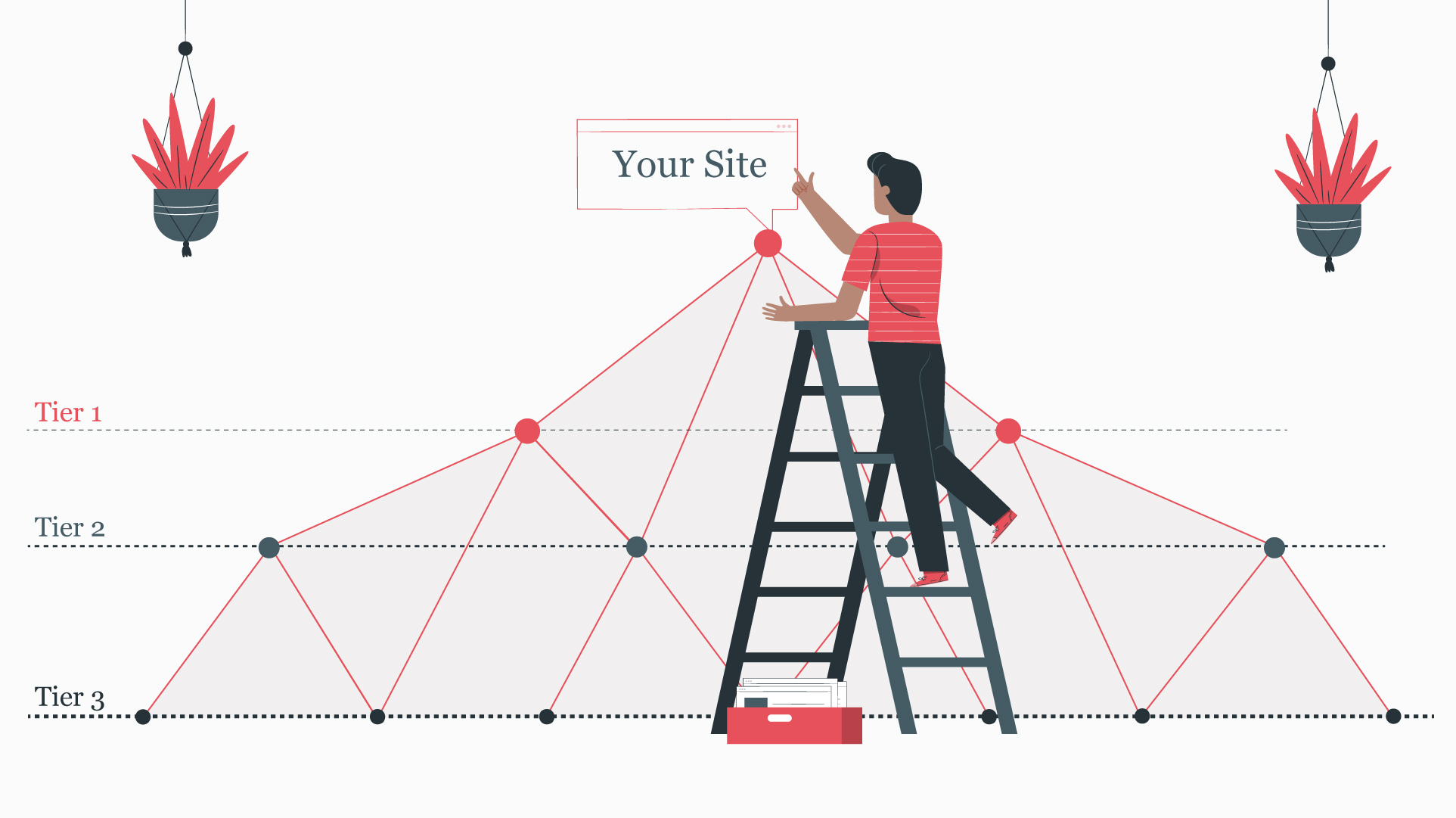
One common mistake that many of us may usually make is not keeping records of the guest posts that we have written and gotten live.
Yes, it may come off as unnecessary labour, until you actually need to go back to any of the guest posts that you have written.

And see, for adequately promoting your guest posts, you’ll need this record. So, create an excel sheet and paste details of all the guest posts that you write and publish.
Now that you have easy and quick access to this data, this is the time when you use it.
So, whenever you write a new guest post, keep this sheet opened in another tab and run a quick scan for old guest posts that may be relevant for being included in this new piece.

By doing this whenever possible, you’ll be building tier links to your target pages and making your
guest posts work for each other.
Ever heard about one stone two birds? It’s the same idea; without hurting any birds.
Remember the top benefits of guest posting? Exposure to a wider audience was one of them, and here we will talk about that.
Once your guest post is live on the blogger’s site, it’ll be visible to the blogger’s audience that may read through the piece written by you, and so, they may leave comments. They may reach out to you. They may check out your website and target pages. They may even surf the web looking for information about you.
In these cases, you’ll have to be responsive towards all sorts of interactions that this new set of audience initiates.

So, whether the audience is leaving comments on the guest post that you wrote or sending you messages on Instagram, actively respond to all these interactions.

This is one another way of sending out the message that you are available for conversations and queries that your audiences may wish to resolve.
Note that, in order to be active with comments on the guest post, you may have to subscribe to the comments on that particular post or keep checking the post from time to time.
So, now that your guest post is live and people are reacting to it, how about appreciating and thanking the blog host for giving you this opportunity?
This will help you build a better relationship with the blog host. Plus, this sweet gesture won’t cost you anything. However, it’ll make sure that this blog remains open even for future guest posts from your side.

Source
Sounds like a great deal, right?
So, take action. Write a sweet thank you note and email it to the guest posting host.
Apart from this, you can also share a handwritten thank you note via post or pictures. Moving further, talking to the blogger about how this guest posting opportunity helped you achieve your goals can also
be a great idea.
Any blog host will appreciate this and thus keep you in their good books.
Ohh yes! You promised to keep your email subscribers notified about everything that happens in and around your business. This is the time for proving your words.
Indeed, if a person has subscribed to your email list, they are probably interested in your business and content. So, put this interest to the right use. Tell your email subscribers about the guest post that you just wrote.

This will boost traffic to the guest post. They’ll get to read another great piece of content that you just created. It’ll make them aware of the fact that you are indulging in exciting collaborations so they must stay tuned.
Another great marketing gimmick for your guest post — getting in touch with the people that you have mentioned.
Many times, these influencers who we talk about in our guest posts are easily approachable and appreciative towards the mention that we made about them. In cases like these, these people may go on to sharing the guest post that talked about them.

This will mean that the guest post that you wrote will be getting an even wider audience base. Plus, this popularity may also be transferred to your target page’s link.
All-in-all, it’s a win-win for all parties — you, the blog host and the people that you mentioned in your guest post.
The comment section of your guest post is always a gold mine for connecting with your prospects.
First of all, these comments work for boosting your confidence as seeing people liking your work is always a motivator. Secondly, by getting in touch with the people that liked your content/work, you may be unlocking many business opportunities for yourself.

So, after you have published a guest post, make sure you stay active in the comments section and try to have a word with every reader that liked the post.
Writing them an email is also a great idea as such one-to-one conversations with your prospects can work wonders for your business.
During your guest posting campaign, you may come across myriads of websites and blogs that may allow guest posting authors to become contributors for the blog.
Do you know what that means?

As long as you are a normal guest author, you’ll have to contact the site owner, again and again, to approve and publish your guest posts. However, if you manage to pull off the contributor tag, a world of link building opportunities will open right after you.
Basically, getting a contributor tag on a blog/website means that you can write, publish, edit and delete your posts on this website, without any moderators’ approval.
Such a great deal, right? Only if you manage to win this tag.
Speaking of how you can become a contributor, some blogs may include the qualifying procedure in their guest posting guidelines (they may also charge a fee for it), some may require you to have a word with them regarding the same, while many of them may not have this on offer.

Also, if you are planning to contact a blog for a contributor account, ensure that you have submitted at least two to three guest posts on the same blog.
This will boost your chances of approval.
Guest posting is like the holy grail of SEO. Everyone wants to excel at it, but it can’t work without the right kind of effort in the right direction.
With this guest posting guide, we tried to make it easier for everyone.
Hopefully, this was the last guest posting guide that you’ve had to refer to.
Guest posting is important because:
You can find guest blogging opportunities through:
Guest blogging is very valuable for SEO because: